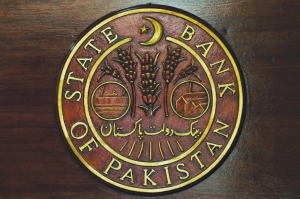Pakistan’s central bank cuts key policy rate by bigger than expected 200 bps


The logo of the State Bank of Pakistan (SBP) is pictured at its head office in Karachi. The SBP bank cut its key policy rate by a bigger than expected 200 basis points to 17.5% on Thursday, the third straight reduction since June as the country looks to spur growth as inflation eases.
Pakistan’s central bank cut its key policy rate by a bigger than expected 200 basis points to 17.5% on Thursday, the third straight reduction since June as the country looks to spur growth as inflation eases.
Most respondents in a Reuters poll had expected the bank’s Monetary Policy Committee (MPC) to cut rates by 150 basis points after inflation fell to single digits in August for the first time in nearly three years.
“The pace of this disinflation has somewhat exceeded the Committee’s earlier expectations,” the State Bank of Pakistan said in a monetary policy statement, attributing this to a delay in the implementation of planned increases in energy prices and falling global oil and food prices.
Thursday’s move follows cuts of 150 basis points in June and 100 basis points in July that have taken the rate down from an all-time high of 22% — set in June 2023 and left unchanged for a year.
Pakistan’s annual consumer price inflation rate slowed to 9.6% in August from a multi-decade high of nearly 40% in May 2023.
“The MPC assessed the real interest rate to still be adequately positive to bring inflation down to the medium-term target of 5-7% and help ensure macroeconomic stability,” the bank said in its statement.
“This would be essential to achieve sustainable economic growth over the medium term,” it said.
The bank said there was a possibility that average inflation for the fiscal year ending mid-2025 would fall below the previous forecast range of 11.5%-13.5%.
Economic indicators have stabilised since last summer when the country came close to a default before a last-gasp bailout from the International Monetary Fund.
However, concerns have risen once again, with the global lender’s board yet to approve a staff level agreement struck in June for a new, $7bn, three-year programme that includes the requirement that Pakistan boost its external financing.
The central bank said its forecasts were partially contingent on “timely” foreign inflows as well as continued fiscal prudence by the government.
The government initially said it expected the board approval in August, and later said it was likely in September. The issue is yet to be placed on the IMF board’s agenda.
However, Pakistan central bank governor Jameel Ahmad told analysts in a briefing following Thursday’s rate cut that external financing requirements had been met, and that he still expected the IMF board’s programme approval in September.
He added that he expected Pakistan’s foreign exchange reserves to increase above $12bn by March, up from $9.5bn currently, as inflows would increase after the IMF approved Pakistan’s programme.





